Introduction: The month of March was relatively calm compared to drier months of July to September mainly due to the lush green forage covering the ecosystem occasioned by good rains for the last few months
Introduction:
The month of March was relatively calm compared to drier months of July to September mainly due to the lush green forage covering the ecosystem occasioned by good rains for the last few months. In the month an elephant was treated for spear wound for the first time in Tsavo east indicating a new trend of poaching in the Park. Another case of the rare elephants in Lamu with a snare attended to. Rains are expected to subside in the coming months and injuries to elephants assume an upward trend as wildlife are forced to walk for longer distances in search for water and forage.
Case #1 Treatment of an injured Elephant cow with a bullet wound on the front right leg:
Date: 14th March 2014
Species: Elephant
Sex: Female
Age: Sub-Adult
Location: Rukinga Ranch
History:
The sub-adult elephant was previously treated for the same injury but did not resolve well prompting a repeat treatment.
Immobilisation:
She was easily located near a water hole in Rukinga ranch and immobilized using 15 mgs of etorphine in a dan inject dart system. She was pushed to the left lateral position. The wound on the distal part of the front right limb was cleaned with water mixed with hydrogen peroxide, pus squeezed out, doused with tincture of iodine and covered with green clay.
Treatment:
Long acting antibiotics, anti-inflammatories and vitamin B12 complex (catasol) was administered to boost the poor body condition. She was declared out of danger and despite assessment of assisting her to wake up she proved otherwise and woke up on her own.
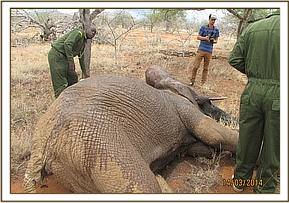

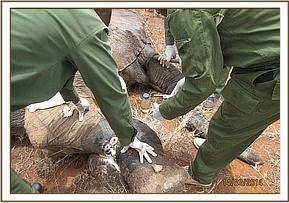

Case #2 Autopsy of a poached Rhino:
Date: 15th March 2014
Species: Rhino
Sex: Male
Location: Ngulia Sanctuary
History:
Security offices manning the Ngulia sanctuary reported hearing gun shots on the evening of 14th March 2014. On search of the area, a dead fresh Rhino carcass was located in the morning around Sierra 2 area within the sanctuary with the horns missing.
General examination:
The male Rhino carcass was leaning on the left flank, facing eastward direction, right ear missing but left ear was intact and notched, horns missing and the area covered by big raw wound cut deep into the sinuses with sharp object marks still visible. Body condition of the carcass was very good scored at 5/5. Penetrating wounds were seen on the right side of the neck behind the mandible and another on the left thoracic area caudal to the left scapula.
Autopsy exam:
The left penetrating wound was opened and muscle tearing of the latisimus dorsi muscle observed in a rostro- caudal direction and after which the bullet lodged under the skin. The penetrating wound on the right side of the neck started caudal to the right mandibular bone passed beneath the trachea ruptured both the carotid artery and the jugular veins and bullet lodged under the skin on the left side of the neck. Two bullet heads were recovered from the carcass and handed over to scene of crime personnel. No other significant findings were seen.
Cause of death:
Haemorrhage from rupture of carotid artery caused by a gun shot.
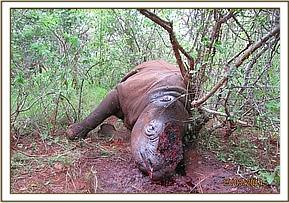

Case #3 Treatment of a speared elephant bull:
Date: 18th March 2014
Species: Elephant
Sex: Male
Age: Adult
Location: Aruba Area, Tsavo East
History:
Report was received of an injured elephant bull that was limping around Aruba dam area was received from tourists visiting the area and the team rushed in to find the slightly lame elephant foraging near the Aruba airstrip.
Immobilisation:
Immobilization was done using 18 mgs of etrophine in a dan inject dart system, the elephant walked for about 5 minutes then fell on the right side. The deep fresh wound on the left foreleg near the elbow was assessed and found to be deep and still fresh.
Treatment:
It was cleaned using diluted hydrogen peroxide and tincture of iodine sprayed on the wound. Green clay was used to cover the wounded area. Long acting antibiotics and painkillers anti-inflammatory drugs were administered by intramascular injection. The bull was finally revived through intravenous injection of diprenorphine hydrochloride intravenously into the ear vein. He woke up and walked away slowly.
Prognosis: Good


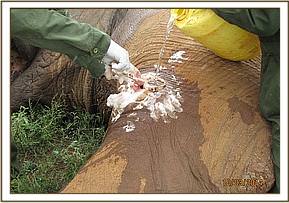


Case #4 Rescue of an abandoned water buck kid:
Date: 22nd March 2014
Species: Water buck Kid
Location: Galana Ranch
History and Rescue:
The water buck kid was rescued at the banks of the swollen Galana River with no mother in site. He was kept in a nearby camp by the camp attendants who contacted the vet unit officers to request for rescue and subsequent transfer to the orphanage. He was rescued stabilized with some oral glucose water and introduced to dilute milk. He was housed for a few days in Voi stockade before being moved to Kibwezi forest as his new home.
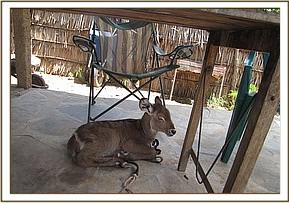

Case #5 Examination of elephant carcasses:
Date: 28th March 2014
Species: Elephant
Sex: one young Male and one Pregnant female
Age: Sub Adult
Location: Pipeline Area, Tsavo East
History:
Two elephant carcasses aged about 4 days from the time of death were spotted near the Aruba- Sala road in Tsavo east national park.
Autopsy:
The area was visited and invasive autopsy could not be carried out due to advanced level of decomposition. Close examination revealed the following:- • No external injuries were observed. • The elephants were a young male and a pregnant young female. • Both died next to each other with no signs of struggle • Both were facing the same direction. • All the tusks were intact • The area is deep inside the park and safe haven of the elephants with very low possibility of poisoning as happens in the boundaries.
Conclusion:
From the deduction above points the most probable cause of the deaths was put as lightning due to the heavy thunderous weather being experienced currently in the region for the last few months.

Case #6 Treatment of an injured young elephant bull:
Date: 30th March 2014
Species: Elephant
Sex: Male
Age: Sub Adult
Location: Kipini Provisional Forest Lamu
History:
Lamu is an area with few remaining elephant population that are very shy due to the high threats of poaching. This specific young elephant bull was seen near Kipini airstrip after fire razed the area. He was limping and in great pain from a tight nylon rope snare around the front left limb. The vet team was flown into the area and easily found the elephant only 50 meters from the airstrip. He was easily immobilized with 15 mgs of etorphine in a dan inject dart system as he walked to a nearby water point to quench his thirst.
Capture and Treatment:
The rope was cut loose and the deep wound cleaned with hydrogen peroxide mixed with water, tincture of iodine applied and green clay used to cover the wound. Long acting antibiotics, anti-inflammatories and vitamin B12 complex were administered by injection. The anaesthesia was reversed using 48 mgs of diprenorphine Hcl. Close monitoring was advised.
Prognosis: Good
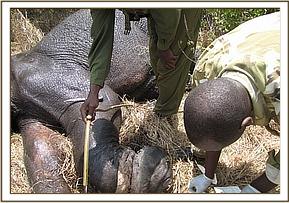


Conclusion and acknowledgement:
The rains are still pouring in Tsavo ecosystem and this is good news as it will keep the heavy feeders like the elephants within the park where it is secure. The case numbers remain low due to the above reasons and also due to heightened security patrols that deter poachers. The unit acknowledges the vital role of its sponsors VIER PFOTEN through the David sheldrick wildlife trust (DSWT) for their continued support to the unit. We also thank the Kenya Wildlife Service management in Tsavo and Nairobi for working with the unit. Report By: Dr. Jeremiah Poghon